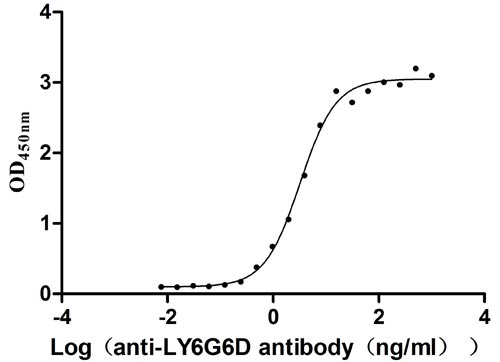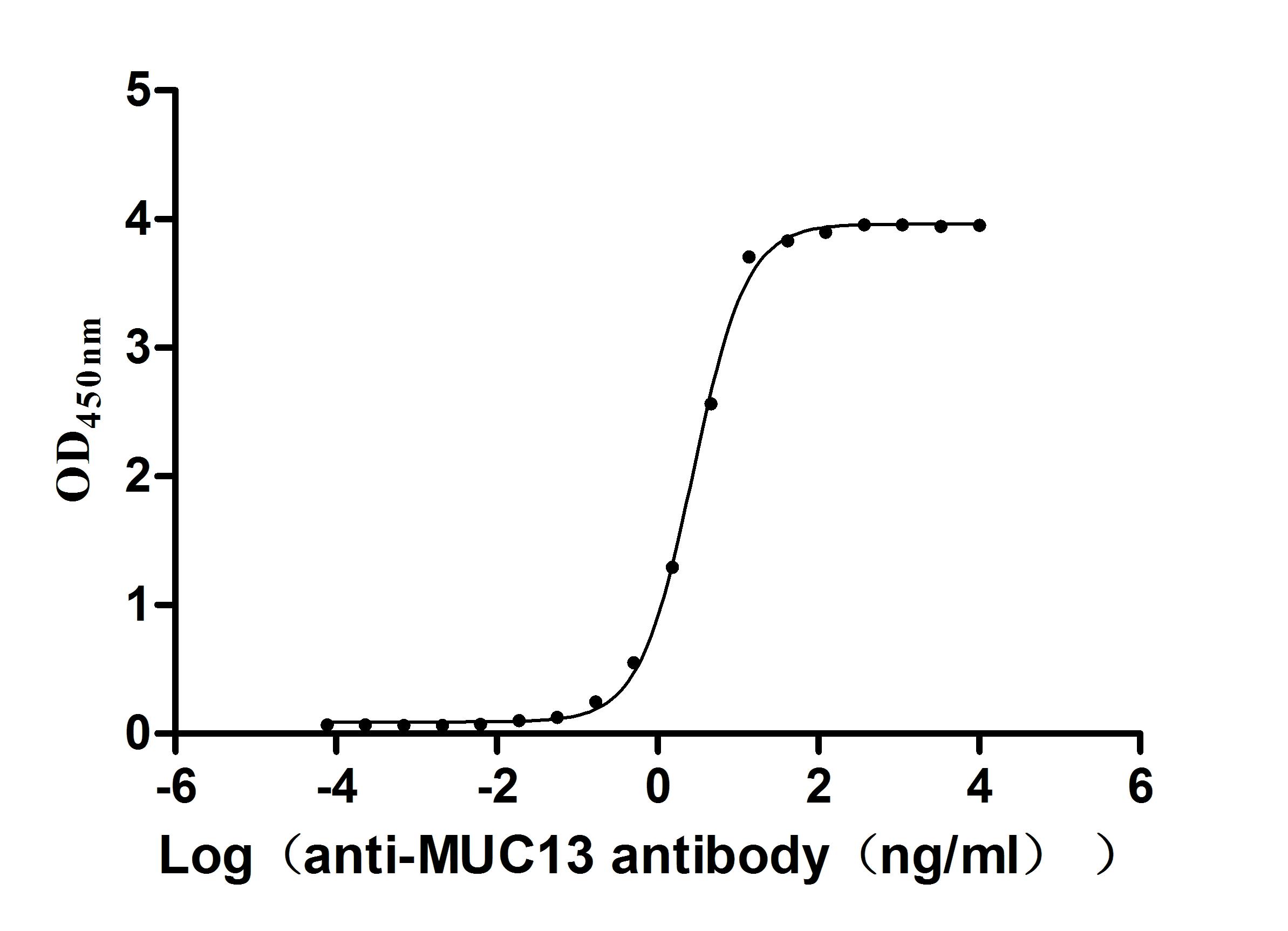Recombinant Human Elongation of very long chain fatty acids protein 4 (ELOVL4)
-
货号:CSB-CF880925HU
-
规格:
-
来源:in vitro E.coli expression system
-
其他:
产品详情
-
基因名:ELOVL4
-
Uniprot No.:
-
别名:ELOVL4; Elongation of very long chain fatty acids protein 4; 3-keto acyl-CoA synthase ELOVL4; ELOVL fatty acid elongase 4; ELOVL FA elongase 4; Very long chain 3-ketoacyl-CoA synthase 4; Very long chain 3-oxoacyl-CoA synthase 4
-
种属:Homo sapiens (Human)
-
蛋白长度:full length protein
-
表达区域:1-314
-
氨基酸序列MGLLDSEPGSVLNVVSTALNDTVEFYRWTWSIADKRVENWPLMQSPWPTLSISTLYLLFV WLGPKWMKDREPFQMRLVLIIYNFGMVLLNLFIFRELFMGSYNAGYSYICQSVDYSNNVH EVRIAAALWWYFVSKGVEYLDTVFFILRKKNNQVSFLHVYHHCTMFTLWWIGIKWVAGGQ AFFGAQLNSFIHVIMYSYYGLTAFGPWIQKYLWWKRYLTMLQLIQFHVTIGHTALSLYTD CPFPKWMHWALIAYAISFIFLFLNFYIRTYKEPKKPKAGKTAMNGISANGVSKSEKQLMI ENGKKQKNGKAKGD
Note: The complete sequence including tag sequence, target protein sequence and linker sequence could be provided upon request. -
蛋白标签:N-terminal 10xHis-tagged
-
产品提供形式:Liquid or Lyophilized powder
Note: We will preferentially ship the format that we have in stock, however, if you have any special requirement for the format, please remark your requirement when placing the order, we will prepare according to your demand. -
缓冲液:Lyophilized from Tris/PBS-based buffer, 6% Trehalose, pH 8.0
-
储存条件:Store at -20°C/-80°C upon receipt, aliquoting is necessary for mutiple use. Avoid repeated freeze-thaw cycles.
-
保质期:The shelf life is related to many factors, storage state, buffer ingredients, storage temperature and the stability of the protein itself.
Generally, the shelf life of liquid form is 6 months at -20°C/-80°C. The shelf life of lyophilized form is 12 months at -20°C/-80°C. -
货期:Basically, we can dispatch the products out in 1-3 working days after receiving your orders. Delivery time may differ from different purchasing way or location, please kindly consult your local distributors for specific delivery time.Note: All of our proteins are default shipped with normal blue ice packs, if you request to ship with dry ice, please communicate with us in advance and extra fees will be charged.
-
注意事项:Repeated freezing and thawing is not recommended. Store working aliquots at 4°C for up to one week.
-
Datasheet & COA:Please contact us to get it.
相关产品
靶点详情
-
功能:Catalyzes the first and rate-limiting reaction of the four reactions that constitute the long-chain fatty acids elongation cycle. This endoplasmic reticulum-bound enzymatic process allows the addition of 2 carbons to the chain of long- and very long-chain fatty acids (VLCFAs) per cycle. Condensing enzyme that catalyzes the synthesis of very long chain saturated (VLC-SFA) and polyunsaturated (PUFA) fatty acids that are involved in multiple biological processes as precursors of membrane lipids and lipid mediators. May play a critical role in early...显示更多
-
基因功能参考文献:
- A highly reduced activity of the ELOVL4 promoter was registered due to combination of two variants. Decrease of ELOVL4 enzymatic activity could lead to a deficiency of VLC-PUFA, essential components for rods function and longevity, which are among the parameters involved in the etiopathogenesis of stargardt disease. PMID: 29417145
- Normalization of retinal ELOVL4 expression could prevent blood-retinal barrier dysregulation in diabetic retinopathy through an increase in very long-chain ceramides and stabilization of tight junctions. PMID: 29362226
- Swiss Family with Dominant Stargardt Disease Caused by a Recurrent Mutation in the ELOVL4 Gene PMID: 27116512
- In the control group, four different genetic variations were detected in ELOVL4, and five in PRPH2. STGD patients of different ethnicities may carry distinct ELOVL4 and PRPH2 sequence variants. We believe that the genetic variations identified in this study may be related to STGD etiopathogenesis. PMID: 27813578
- In patients with intrahepatic cholestasis of pregnancy, there was no elevation in ELOVL4 mRNA in maternal circulation compared with controls. PMID: 25059952
- Both ELOVL4- and PROM1-related maculopathies are characterized by progressive photoreceptor atrophy and central vision loss. Using advanced diagnostic imaging, early disease changes and disease progression can be characterized. PMID: 26110599
- different mutations in ELOVL4 can cause variable phenotypic neurological disorders (Review) PMID: 26427403
- Spinocerebellar ataxia was associated with a novel mutation in ELOVL4 in a large family pedigree. PMID: 26010696
- In this review, we summarize our current understanding of the disease-causing mutation and its potential role in STGD3 pathogenesis. PMID: 24664730
- We propose that transgenic expression of ELOVL4 in the liver will result in the biosynthesis of very long chain-PUFA that can be transported to target. PMID: 24664752
- ELOVL4 is identified as the causative gene for erythrokeratodermia variabilis and spinocerebellar ataxia in a French-Canadian family. PMID: 24566826
- A novel homozygous nonsense mutation in ELOVL4 cuases a neuro-ichthyotic disorder with variable expressivity. PMID: 24571530
- Coexpression of different forms of wild-type and mutant ELOVL4 revealed a large dominant-negative effect of mutant protein on ELOVL4 localization and enzymatic activity, resulting in reduced VLC-PUFA synthesis. PMID: 23509295
- 5 single nucleotide polymorphisms (SNPs: rs3812153, rs7764439, rs390659, rs434102 and c:929G>A) were detected in ELOVL4. PMID: 22948568
- Mutation in ELOVL4 gene is associated with Stargardt Disease. PMID: 22863181
- recessive mutations in ELOVL4 as the cause of a neuro-ichthyotic disease PMID: 22100072
- Not only the ELOVL4-ELOVL4DeltaC homo-oligomeric interaction, but also several hetero-oligomeric interactions, may contribute to the pathology of Stargardt disease 3. PMID: 21139992
- There was no association between the M299V variant in ELOVL4 gene and exudative age-related macular degeneration in a Chinese population. PMID: 20388345
- Pathogenic mutations found in the ELOVL4 gene result in altered trafficking of the protein and behave with a dominant negative effect. PMID: 20096366
- Recessive retinitis pigmentosa and Leber congenital amaurosis are rarely if ever associated with changes in the ELOVL4 gene. PMID: 12592226
- The ELOVL4 gene is highly conserved throughout evolution and is expressed in the photoreceptor cells of the retina in a variety of different species PMID: 12824221
- DNA sequence analysis showed a 5-bp deletion in exon 6 of the ELOVL4 gene, confirming the diagnosis of autosomal dominant Stargardt-like macular dystrophy. PMID: 12967813
- mutations in ELOVL4 result in the intracellular misrouting of the protein in macular degeneration PMID: 15028284
- ELOVL4 contributes to the autosomal dominant inheritance of Stargardt-like macular dystrophy PMID: 16036915
- analysis of non-pathogenic polymorphisms in the ELOVL4 in Chinese patients with autosomal dominant STGD3-like macular dystrophy PMID: 16364203
- This study demonstrates that dietary factors can influence the severity of an inherited human macular dystrophy. PMID: 16476896
- No association with AMD was detected with Met299Val polymorphism in the ELOVL4 gene in the familial or sporadic cases compared to non-AMD or blood donor controls. PMID: 16885922
- Role for Elovl4 in acylceramide synthesis, and in particular, a role in the synthesis of the unique very long chain C30-C40 fatty acids present in skin acylceramides. PMID: 17356513
- mutational analysis shows ELOVL4 is not involved in the pathogenesis of RP25 PMID: 11474659
收起更多
-
相关疾病:Stargardt disease 3 (STGD3); Ichthyosis, spastic quadriplegia, and mental retardation (ISQMR); Spinocerebellar ataxia 34 (SCA34)
-
亚细胞定位:Endoplasmic reticulum membrane; Multi-pass membrane protein.
-
蛋白家族:ELO family, ELOVL4 subfamily
-
组织特异性:Expressed in the retina and at much lower level in the brain. Ubiquitous, highest expression in thymus, followed by testis, small intestine, ovary, and prostate. Little or no expression in heart, lung, liver, or leukocates.
-
数据库链接:
HGNC: 14415
OMIM: 133190
KEGG: hsa:6785
STRING: 9606.ENSP00000358831
UniGene: Hs.101915


















